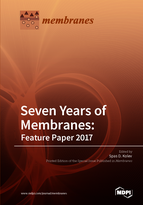Seven Years of Membranes: Feature Paper 2017
A special issue of Membranes (ISSN 2077-0375).
Deadline for manuscript submissions: closed (30 September 2017) | Viewed by 99722
Special Issue Editor
Interests: ion-exchange and liquid membranes; membrane applications in passive sampling; flow analysis; water treatment; chemical sensing; synthesis of metal nanoparticles
Special Issues, Collections and Topics in MDPI journals
Special Issue Information
Dear Colleagues,
To celebrate the seventh year of the publication of Membranes, I have the honor to edit a new Special Issue. The Special Issue will collect original research papers from the frontiers of membrane research, as well as review articles from prominent scholars, highlighting the state-of-the-art of membrane science and technology. I invite researchers and technologists, whose work focuses on membranes and related applications, to contribute with papers disseminating their excellent research findings. We are looking forward to receiving your work.
Prof. Dr. Spas D. Kolev
Guest Editor
Manuscript Submission Information
Manuscripts should be submitted online at www.mdpi.com by registering and logging in to this website. Once you are registered, click here to go to the submission form. Manuscripts can be submitted until the deadline. All submissions that pass pre-check are peer-reviewed. Accepted papers will be published continuously in the journal (as soon as accepted) and will be listed together on the special issue website. Research articles, review articles as well as short communications are invited. For planned papers, a title and short abstract (about 100 words) can be sent to the Editorial Office for announcement on this website.
Submitted manuscripts should not have been published previously, nor be under consideration for publication elsewhere (except conference proceedings papers). All manuscripts are thoroughly refereed through a single-blind peer-review process. A guide for authors and other relevant information for submission of manuscripts is available on the Instructions for Authors page. Membranes is an international peer-reviewed open access monthly journal published by MDPI.
Please visit the Instructions for Authors page before submitting a manuscript. The Article Processing Charge (APC) for publication in this open access journal is 2700 CHF (Swiss Francs). Submitted papers should be well formatted and use good English. Authors may use MDPI's English editing service prior to publication or during author revisions.







